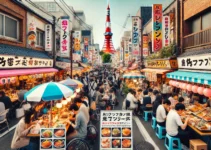Singapore is a bustling island city-state that is a food lover’s delight when it comes to street cuisine. Singapore is well known for its thriving street food scene, offering a delectable variety of delicacies that showcase the country’s rich ethnic diversity. The street food in Singapore offers a mouthwatering culinary experience that will entice your taste buds, ranging from savory appetizers to substantial dinners.

A Melting Pot of Flavors
Singapore’s street food aptly reflects the city-state’s actual cultural melting pot status. With flavors from Chinese, Malay, Indian, and Peranakan cuisines, Singapore’s street food is as tasty as it is varied. The hub of this food culture is the city’s hawker centers, which are essentially outdoor food courts with an amazing array of cuisines at reasonable costs.
Discovering Singapore’s street food is essential, regardless of your level of culinary expertise or curiosity as a tourist. Let’s explore the world of hawker centers and learn about some of the most well-known foods that you must try.
The Hawker Center Experience
An essential component of Singaporean street cuisine are hawker centers. Both locals and visitors congregate at these hive centers of culinary activity to savor a variety of meals, with each stall specializing in a particular cuisine. The sounds of sizzling woks, the smell of spices, and the sight of colorful food displays create a dynamic scene.
The enormous selection of cuisine at hawker centers is one of its greatest features. You’re sure to find something here to suit your taste, be it salty, sweet, or spicy. These locations’ communal seating enhances the experience even more by letting you explore Singapore’s street food scene over a table with others and perhaps even pick up some insider advice on what to try next.
Must-Try Street Food in Singapore
With so many options to choose from, it can be overwhelming to know where to start. Here’s a guide to some of the must-try dishes that are iconic in the street food of Singapore, giving you a taste of the island’s culinary diversity.
1. Hainanese Chicken Rice
Hainanese Chicken Rice is often considered Singapore’s national dish, and it’s easy to see why. This deceptively simple dish consists of tender poached chicken served with fragrant rice cooked in chicken stock, accompanied by a trio of sauces: chili, ginger, and dark soy. The secret to a great Hainanese Chicken Rice lies in the quality of the chicken and the flavor of the rice, which should be rich and aromatic. It’s a staple in the street food of Singapore.
Where to Try: Tian Tian Hainanese Chicken Rice at Maxwell Food Centre is one of the most famous stalls for this dish, often drawing long lines of hungry customers eager to taste this staple of the street food of Singapore.
2. Char Kway Teow
Char Kway Teow is a beloved street food of Singapore, featuring flat rice noodles stir-fried with eggs, Chinese sausage, fishcake, bean sprouts, and prawns. The dish is cooked in pork lard and seasoned with dark soy sauce, giving it a rich and smoky flavor. The key to a great Char Kway Teow is the “wok hei,” or the breath of the wok, which imparts a distinct smokiness to the dish.
Where to Try: Hill Street Fried Kway Teow at Chinatown Complex is known for its exceptional version of this dish, cooked to perfection with a generous amount of ingredients, making it a highlight of the street food of Singapore.
3. Laksa
Laksa is a spicy noodle soup that is a staple in the street food of Singapore. This dish is a blend of Chinese and Malay influences, featuring thick rice noodles served in a rich and spicy coconut curry broth. It’s typically topped with ingredients like prawns, fishcake, and cockles, and garnished with fresh herbs.
Where to Try: 328 Katong Laksa is one of the most famous spots to enjoy this dish, with a recipe that has been perfected over the years, making it a must-try in the street food of Singapore.
4. Satay
Satay is a popular dish throughout Southeast Asia, and it’s a significant part of the street food of Singapore. These skewered and grilled meats are marinated in a blend of spices and served with a sweet and spicy peanut sauce. Satay can be found in many forms, such as chicken, beef, mutton, and even pork, each offering its own unique flavor profile. Satay is often enjoyed as a snack or appetizer and is best paired with a side of cucumber, onion, and rice cakes.
Where to Try: Lau Pa Sat, also known as Telok Ayer Market, is famous for its Satay Street, where you can find countless vendors grilling up these delicious skewers—a true gem in the street food of Singapore.
5. Chili Crab
Chili Crab is another iconic dish that represents the essence of the street food of Singapore. This dish features fresh crabs cooked in a thick, tangy, and spicy tomato-based sauce. The sauce is the star of the dish, combining sweet, spicy, and savory flavors. It’s best enjoyed with a side of mantou (fried or steamed buns) to soak up the rich sauce.
Where to Try: Although Chili Crab is more commonly found in seafood restaurants, you can also find it at select hawker stalls like those at East Coast Lagoon Food Village, making it an essential part of the street food of Singapore.
6. Nasi Lemak
Nasi Lemak is a Malay dish that has become a staple in the street food of Singapore. It consists of fragrant rice cooked in coconut milk, served with a variety of sides including fried chicken, fried fish, sambal (spicy chili paste), boiled eggs, peanuts, and anchovies. The dish is typically wrapped in a banana leaf, which adds to its aromatic quality.
Where to Try: Selera Rasa Nasi Lemak at Adam Road Food Centre is a popular spot for this dish, known for its flavorful rice and delicious accompaniments, solidifying its place in the street food of Singapore.
7. Roti Prata
Roti Prata is an Indian-inspired flatbread that is crispy on the outside and soft on the inside. It’s typically served with a side of curry for dipping but can also be enjoyed with sugar or condensed milk for a sweet treat. Roti Prata is a popular breakfast dish in Singapore, but it’s also enjoyed throughout the day, making it a beloved part of the street food of Singapore.
Where to Try: Mr. and Mrs. Mohgan’s Super Crispy Roti Prata at Joo Chiat is a local favorite, known for its perfectly crispy prata and an essential experience in the street food of Singapore.
8. Hokkien Mee
Hokkien Mee is a stir-fried noodle dish that combines both yellow noodles and rice vermicelli. The dish is cooked with prawns, squid, eggs, and bean sprouts in a rich prawn broth, and is typically garnished with sambal chili and a squeeze of lime. The combination of flavors and textures makes Hokkien Mee a comforting and satisfying dish within the street food of Singapore.
Where to Try: Kim’s Hokkien Mee at Geylang is a well-known stall that has been serving this dish for decades, with a reputation for its flavorful broth and generous portions, making it a staple in the street food of Singapore.
The Evolution of Singapore’s Street Food Scene
The street food of Singapore has evolved significantly over the years. What began as informal roadside stalls has transformed into a well-organized and regulated network of hawker centers, thanks in part to the government’s efforts to maintain food hygiene and safety standards. Despite these changes, the essence of street food of Singapore has remained intact, with hawker centers continuing to be the go-to spots for affordable and delicious meals.
The recognition of Singapore’s hawker culture by UNESCO as an Intangible Cultural Heritage of Humanity in 2020 further solidified the importance of street food of Singapore in the country’s identity. This acknowledgment not only celebrates the culinary diversity of Singapore but also highlights the role of hawkers in preserving and passing down traditional recipes through generations.
A Day in the Life of a Hawker
Every excellent dish found in Singapore’s street cuisine is the result of years of dedication and skill on the part of hawkers. Being a hawker is not an easy life; it requires a great love of food, long hours, and hard labor. In order to ensure that everything is ready for the breakfast rush, many hawkers begin their day before the sun comes up by chopping ingredients and setting up their stands.
Hawkers can concentrate on honing the flavors and preparation methods by specializing in one dish or a limited number of dishes. Because each dish is prepared by someone who has spent years perfecting their craft, this specialization is one of the reasons Singapore’s street cuisine is so consistently excellent.
Many hawkers consider their stand to be a way of life rather than just a place of commerce. The hawker culture in Singapore and the whole experience of Singaporean street cuisine are deeply ingrained in the relationships they forge with their patrons, the pride they take in their food, and the joy they provide to others.
The Future of Street Food in Singapore
As Singapore continues to modernize, there are concerns about the future of its street food culture. The younger generation is less inclined to take up the hawker trade, which is seen as a tough and unglamorous career path. To address this, initiatives have been introduced to encourage more young people to become hawkers, including mentorship programs, grants, and support for new hawkerpreneurs, ensuring the preservation of the street food of Singapore.
Additionally, there is a growing trend towards healthier and more sustainable street food options. Some hawkers are experimenting with organic ingredients, plant-based dishes, and eco-friendly packaging to cater to the evolving tastes of consumers. These innovations are helping to keep the street food of Singapore vibrant and relevant in a changing world.
How to Navigate Singapore’s Street Food Scene
With so many delicious options available, it can be challenging to navigate the street food of Singapore, especially if you’re visiting for the first time. Here are some tips to help you make the most of your culinary adventure:
- Do Your Research: Before heading to a hawker center, take some time to research the must-try stalls and dishes. Websites, blogs, and food apps can provide valuable insights and recommendations on the street food of Singapore.
- Be Adventurous: Don’t be afraid to try something new! The street food of Singapore is all about exploration and discovery. Whether it’s a dish you’ve never heard of or a flavor combination that sounds unusual, give it a go—you might be pleasantly surprised.
- Pace Yourself: With so much food to try, it’s easy to overindulge. Pace yourself by ordering small portions or sharing dishes with friends so you can sample a wider variety of food, experiencing more of the street food of Singapore.
- Observe the Locals: If you’re unsure which stall to try, look for the ones with long lines of locals. This is usually a good indicator of quality and popularity in the street food of Singapore.
- Bring Cash: While some hawker centers now accept digital payments, many still operate on a cash-only basis. Make sure to have some cash on hand to avoid any inconvenience and fully enjoy the street food of Singapore.
Street Food Etiquette
When enjoying the street food of Singapore, it’s important to be mindful of the local etiquette. Here are a few tips to keep in mind:
- Queue Up: Singaporeans take their food seriously, and queuing is part of the experience. Be patient and wait your turn—it’s considered respectful to do so when experiencing the street food of Singapore.
- Return Your Tray: Many hawker centers now have tray return stations. After finishing your meal, make sure to return your tray and dispose of any rubbish, respecting the communal nature of the street food of Singapore.
- Respect the Space: Hawker centers can get crowded, especially during peak hours. Be mindful of your space and avoid hogging tables, especially if others are waiting for a seat.
- Be Considerate: Street food stalls are often busy and fast-paced, so try to order efficiently and avoid making special requests that might slow down the process, ensuring a smooth experience for everyone enjoying the street food of Singapore.
Beyond the Food: The Cultural Significance of Street Food in Singapore
Singapore’s street cuisine is a reflection of the island’s diversified community and rich history, not just a means of satisfying your hunger. Generations of immigration have shaped the food found at hawker centers by bringing their culinary traditions with them, combining and modifying them to produce a distinctively Singaporean cuisine.
Hawker centers’ social atmosphere also contributes significantly to the gathering of individuals. Everyone congregates in a common area to eat the same delectable meal, regardless of wealth or poverty, whether they are tourists or locals. One of the things that makes Singaporean street food so unique is this feeling of camaraderie.
Furthermore, Singapore’s street cuisine narrates the history of the island, from its modest origins as a trading port to its rise to prominence as a major world city. The enduring and versatile nature of Singapore’s culinary culture is demonstrated by the development of hawker centers and the maintenance of traditional recipes.
Conclusion: A Culinary Journey You’ll Never Forget
Learning about Singapore’s street cuisine is an experience unlike any other. It’s a chance to discover how many different tastes, customs, and cultural traditions are woven together into one dish. Every mouthful provides a window into the spirit and heart of Singapore, whether you’re relishing a dish of Hainanese Chicken Rice, relishing the smokey flavor of Char Kway Teow, or relishing the spice of Laksa.
Thus, don’t forget to tuck on Singaporean street cuisine the next time you’re in this energetic city. In addition to sating your appetite, you’ll develop a greater understanding of Singapore’s rich culinary legacy, which elevates the country to the status of one of the world’s top culinary destinations.


